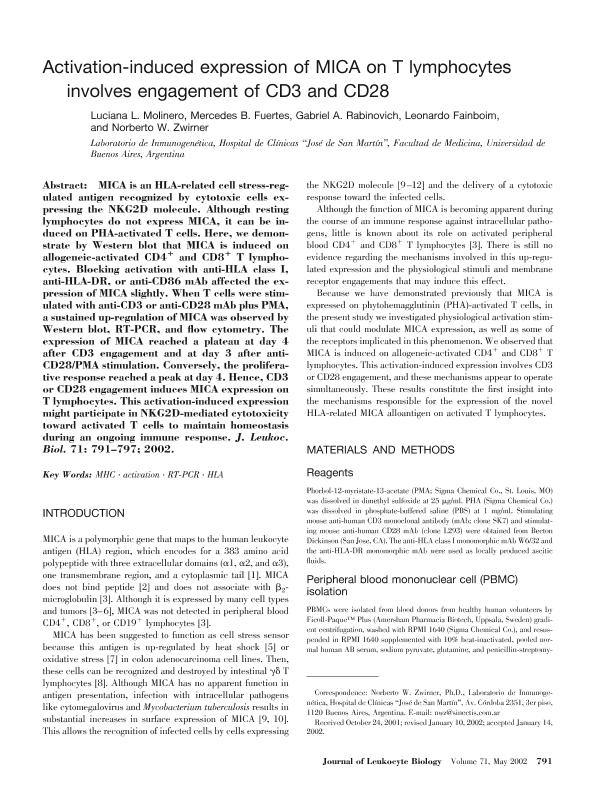Artículo
Activation-induced expression of MICA on T lymphocytes involves engagement of CD3 and CD28
Molinero, Luciana Lorena ; Fuertes, Mercedes Beatriz
; Fuertes, Mercedes Beatriz ; Rabinovich, Gabriel Adrián
; Rabinovich, Gabriel Adrián ; Leonardo Fainboim; Zwirner, Norberto Walter
; Leonardo Fainboim; Zwirner, Norberto Walter
 ; Fuertes, Mercedes Beatriz
; Fuertes, Mercedes Beatriz ; Rabinovich, Gabriel Adrián
; Rabinovich, Gabriel Adrián ; Leonardo Fainboim; Zwirner, Norberto Walter
; Leonardo Fainboim; Zwirner, Norberto Walter
Fecha de publicación:
05/2002
Editorial:
Federation of American Societies for Experimental Biology
Revista:
Journal of Leukocyte Biology
ISSN:
0741-5400
Idioma:
Inglés
Tipo de recurso:
Artículo publicado
Clasificación temática:
Resumen
MICA is an HLA-related cell stress-regulated antigen recognized by cytotoxic cells expressing the NKG2D molecule. Although resting lymphocytes do not express MICA, it can be induced on PHA-activated T cells. Here, we demonstrate by Western blot that MICA is induced on allogeneic-activated CD4(+) and CD8(+) T lymphocytes. Blocking activation with anti-HLA class I, anti-HLA-DR, or anti-CD86 mAb affected the expression of MICA slightly. When T cells were stimulated with anti-CD3 or anti-CD28 mAb plus PMA, a sustained up-regulation of MICA was observed by Western blot, RT-PCR, and flow cytometry. The expression of MICA reached a plateau at day 4 after CD3 engagement and at day 3 after anti-CD28/PMA stimulation. Conversely, the proliferative response reached a peak at day 4. Hence, CD3 or CD28 engagement induces MICA expression on T lymphocytes. This activation-induced expression might participate in NKG2D-mediated cytotoxicity toward activated T cells to maintain homeostasis during an ongoing immune response.
Archivos asociados
Licencia
Identificadores
Colecciones
Articulos(IBYME)
Articulos de INST.DE BIOLOGIA Y MEDICINA EXPERIMENTAL (I)
Articulos de INST.DE BIOLOGIA Y MEDICINA EXPERIMENTAL (I)
Articulos(SEDE CENTRAL)
Articulos de SEDE CENTRAL
Articulos de SEDE CENTRAL
Citación
Molinero, Luciana Lorena; Fuertes, Mercedes Beatriz; Rabinovich, Gabriel Adrián; Leonardo Fainboim; Zwirner, Norberto Walter; Activation-induced expression of MICA on T lymphocytes involves engagement of CD3 and CD28; Federation of American Societies for Experimental Biology; Journal of Leukocyte Biology; 71; 5; 5-2002; 791-797
Compartir



